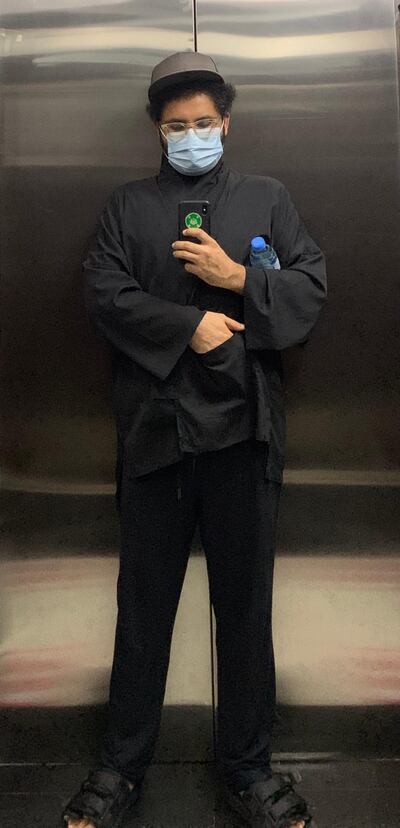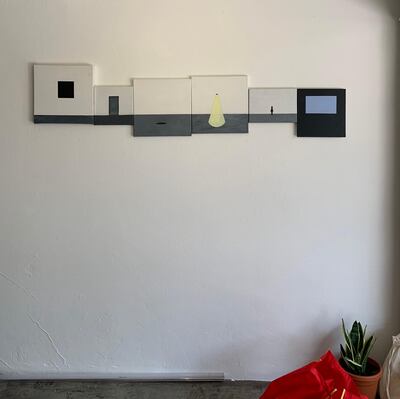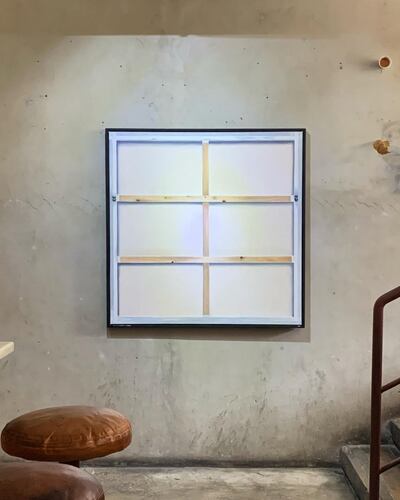"A lot of time I find the back of artworks more beautiful than the front," says Dubai artist and art collector Rami Farook. "There is a mystery to just seeing the back and wondering, what is on the front? Is it blank? Is it beautiful? Is it horrible?"
Farook has opened a retrospective of his paintings in Dubai, curated by Ruba Al-Sweel, at the restaurant and exhibition space Maisan in Al Barsha South. Some of the works are from 2014, made in his studio at Satellite in Alserkal Avenue, but there are also more recent paintings created at home during the coronavirus pandemic.
They blend elements of his autobiography: there are almost claustrophobic drawings he made of online content at the time movement restrictions were in place, as well as a painting he worked up from a canvas his daughter began and later discarded.
In a painting made of a canvas stretcher (a painting of the back of this painting, 2020), done in hyperrealist style in collaboration with Nigerian artist Wisdom, he shows the literal back-end of production.
The art context as subject is fitting for Farook, whose galleries Satellite and Traffic played an important role in the 2000s in establishing the roots of the city's current art scene.
Traffic and Satellite, which Farook established in Al Barsha and Alserkal Avenue respectively, were two of the first exhibition spaces in Dubai. They became a key part of the scene that was orientated around Art Dubai and the publication Bidoun, and which deliberately looked towards the international circuit.
At Traffic, Farook represented a number of artists who are now part of the Gulf establishment, such as Ahmed Mater, Abdulnasser Gharem, Ramin and Rokni Haerizadeh and Hesam Rahmanian.
Farook's exhibition item discontinued shows glimpses of the period after he withdrew from a public-facing role. In 2012, he became an artist himself, showing his work alongside the different artists he supported. Satellite slowed down its activities, though it still hosts some pop-up exhibitions, and Farook began using it more as a studio.
“It was always about creation, exhibition and exchange,” he says of his early ventures. “Supporting artists in creating, whether it’s funding their works, or getting them studio space, or exhibiting them, doing art fairs, publishing books. That was my role, always on the supportive side, but eventually I needed a break and ended up becoming an artist as well.”
But the promise of the gallery as a concept hasn’t left him, and repeatedly features in his paintings as a site of possibility.
A series of six canvases, arranged together to create a horizon line running across them, imagines exhibition spaces dotted with states of emptiness and possibility: dark black voids, blank projections, a hole in the floor. Another pictures an artist alone in the gallery site.
“There is something about the gallery that has a sense of freedom,” he says. “When you walk into an empty space, an empty gallery, how do you intervene in that space?”
Other works show Farook testing the properties of his art materials. In a series from 2015 to 2016, each work is titled a portrait. He has laid materials such as rope and mesh down on canvases and set fire to the assemblages, leaving the charred scars like organic abstractions. For a landscape from 2015, he left a print in the rain, letting the water blur the edges of the image's dark sky.
Al-Sweel, an arts writer in Dubai who is making her curatorial debut, has described Farook's work as "diaristic," referring not only to the autobiographical elements, but also his practice of documenting the moments of his life, whether in his artwork or on Instagram. His tagline on the social media site reads: "If I'm an artist, then anything I do may be art."
Farook attributes this tendency to document things not only to the omnipotence of social media, but also to newspapers. “I grew up reading the paper every day,” he says. “I fell in love with publishing.”
Ironically, the exhibition comes at a time when Farook is returning to exhibition-making. He set up Maisan two years ago, and has used it to show works from his family collection, by artists such as Andy Warhol, Julian Opie and Abdulnasser Gharem.
From 2017 until last year he ran the cafe and store General 3am in D3, which curated art, music and fashion, and he plans a new art and food programme for Satellite in Alserkal Avenue.
“There was a long break from the madness and then it restarted again around 2017 and 2018,” he says, with a laugh. “A lot of people left – and then all of a sudden these kids popped up, with all these new ideas.”
Rami Farook's exhibition item discontinued runs until Wednesday, September 30, at Maisan, Al Barsha South, Dubai





